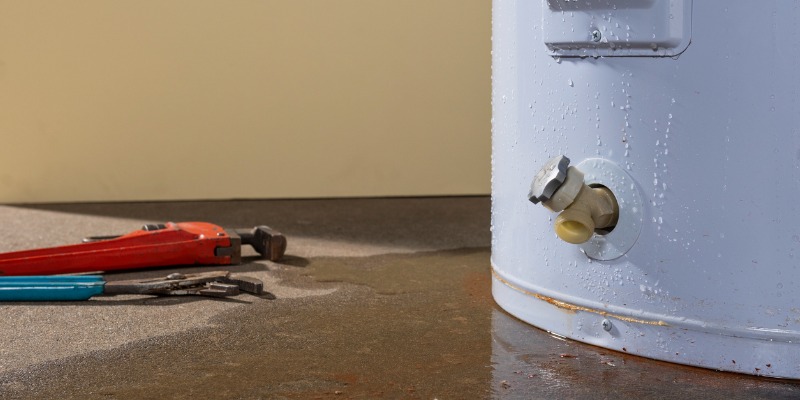
While a water heater can last for about 8-12 years, it can start leaking before then. If you spot drips or pooling around your water heater, you should investigate further to get a grip of what the problem might be.
Water heater leaks can occur for various reasons, from something as simple as a slightly open drain valve to a severe issue such as a corroded hot water tank. This post will walk you through the appropriate steps to take if your water heater is leaking.
Why Is My Water Heater Leaking?
The most common reasons for water pooling near your water heater or dripping from the hot water tank or pipes are:
- Age: With time, the natural minerals in water, such as calcium, can build up inside the water heater and corrode the tank.
- High water pressure: If your water pressure is too high, this can strain the drain valve, the temperature-pressure relief (TPR) valve, or other components.
- Faulty components: Other components can become faulty, leading to a leak at the supply pipes or elsewhere.
Are you looking to speak with an HVAC Expert? Contact the team at B&B ClimateCare today!
What to Do If Your Water Heater is Leaking
The first thing you’ll want to do is determine where the leak is located:
1. TPR valve is leaking
A faulty TPR valve or debris inside the water heater can prevent your water heater from operating correctly. This is especially true with older water heaters.
What to do
Place a bucket under the overflow tube and pull the tab on the TPR valve. The valve will open and any debris or particles will be flushed out. If the valve still leaks, you may need to get a new one, and it is best to contact an HVAC specialist to perform the repair.
If it is leaking at the connection to the water tank, use a wrench to tighten the connection. You can wrap Teflon tape around the threaded connection to the tank if tightening the valve doesn’t stop the leaking.
2. Coldwater inlet valve is leaking
If the valve is faulty, it will drip water down the pipe and onto the top of your water heater. A loose pipe fitting is another common cause for water leaking from the cold inlet valve.
What to do
Take a pipe wrench to tighten the loose connection. If, after tightening, it continues to leak, you may need to replace a section of piping. This will require the help of a professional.
3. Overflow pipe is leaking
The TPR valve drains excess water to prevent excess pressure inside the tank. Excess pressure can cause water to run down from the TPR valve, through the overflow pipe and to the floor.
What to do
Turn the water heater thermostat to its lowest setting, then turn on the power and water supply. You should then observe your water heater for a short time. If leaking doesn’t stop, shut everything off and call a professional to look at it.
4. Water heater tank is leaking
A water heater deteriorates with age, so if it’s old and you don’t know why it is leaking, the issue is most likely with the tank itself. The leaking might be due to corrosion of the tank’s walls from aging and rust.
What to do
Please do not attempt to repair it yourself because of the excessive pressure inside the tank. The best solution is to buy a new water heater, an HVAC professional will be able to walk you through your repair or replace options.
Wrapping Things Up
A water heater leaking may indicate several problems, ranging from loose drain valves to a corroded water tank. In most cases, you’ll have to contact an HVAC professional to help with the repair or replace your water heater.
For help with your water heater contact the experts at B&B ClimateCare today.






